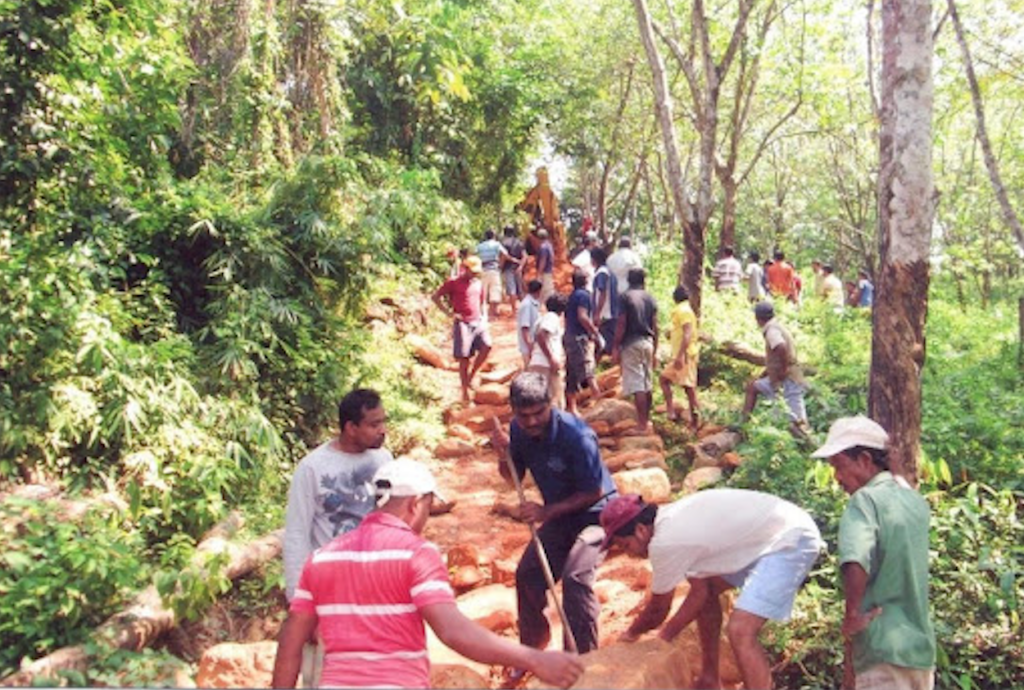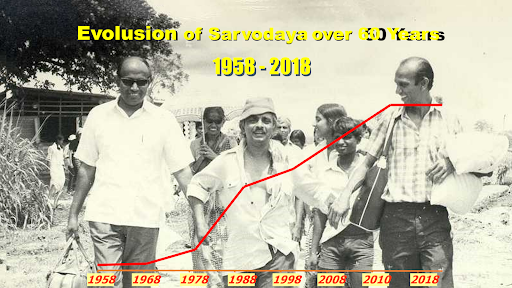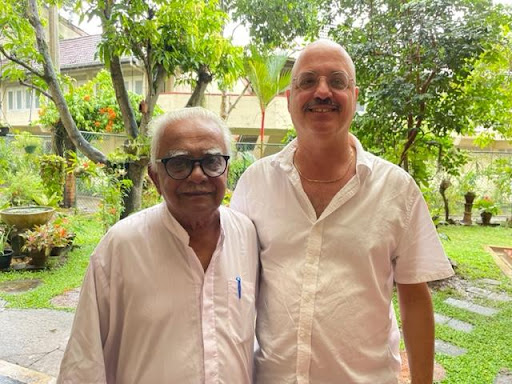
Sarvodaya’s Pathway Can Work Anywhere
cross-posted from Shareable
Over the past six months, Sri Lanka has been in the news. You have likely read accounts or seen videos of a civil revolution sparked by government corruption and shortages of both food and fuel. Amidst this uprising — involving all religions, ethnicities, and classes of the population with a call for systems change — thousands of protestors stormed and occupied the presidential palace, forcing the president to flee in July.
In a world beset by supply chain issues, where the war in Ukraine is one of the multiple factors compromising the world’s food supply, it seems that Sri Lanka is the proverbial “canary in the coal mine.” It’s the first domino to fall, as a worldwide globalized economy based on large-scale, corporate monoculture and shipping food halfway across the planet wobbles toward collapse.
Behind the curtain, a movement builds
Beyond the headlines, though, there is an untold story of how the people of Sri Lanka have managed during this crisis, a story that offers a pathway to resilience and “thrival” that can be adopted (and adapted) by any country, bioregion, or neighborhood. Quietly and behind the scenes, a unique non-government organization called Sarvodaya has mobilized a national network of thousands of self-sufficient villages to do what “official” organizations could not.
Founded more than 60 years ago by Dr. A.T. Ariyaratne, a Gandhi follower, Sarvodaya Shramadana translates to “the Awakening of All through the sharing of energy.” The term Sarvodaya was first used by Gandhi to describe his own political philosophy: “Universal uplift.”

Since its inception, Sarvodaya has grown to include more than 15,000 villages and has energized these communities to build more than 5,000 preschools, community health centers, libraries, and cottage industries. It has also established thousands of village banks and more than 100,000 small businesses — all without any government support. Their slogan characterizes the relationship between spiritual and economic development: “We build the road, and the road builds us.”
Principles in action, halfway across the world
Ever since I first read about Dr. Ari and Sarvodaya more than thirty years ago, they have been a major inspiration for my life’s work including the launch of what I now call Symbiotic Networks. Examples include a neighborhood peace initiative in a low-income, multi-ethnic neighborhood in San Diego, California, a “buy local” campaign, and a food system and neighbor-to-neighbor networks in Reno, Nevada.
It was Sarvodaya’s seamless integration of spirituality and the group’s ability to build bioregional ecosystem networks — creating a new society in the midst of the old — that captured my full attention. Even today, with multiple, global crises, there is no other movement offering humanity such a clear path forward. Through their national network of 15,000 villages and towns with “Sarvodaya Societies,” they have built a parallel organizational network scaffolding for a new society, right alongside the official local and national governments.
Connecting with the movement’s roots
I’ve visited Sarvodaya twice in my life — in 2012 to commemorate a Buddhist Temple Dr. Ari built, where I met my wife Marta. And again, in 2022, after an invite to Dr. Ari’s 90th birthday, where I ended up meeting with his son, Dr. Vinya Ariyaratne, the President of Sarvodaya.
Dr. Ariyaratne is a tireless individual who, in his father’s footsteps, has continued to expand the legacy of the movement. When I shared my experience of building Symbiotic Networks (translating Sarvodaya principles) around local food systems and local economies, he became excited. Life came full circle as I realized I might be able to offer support to Sarvodaya and Vinya for the next level of bio-regional self-reliance and economic development.

The timing was perfect as Vinya and Dr. Ari already wanted to press ahead mapping out their New Economy Movement campaign. The goal was to connect resources impacting thousands of communities, hundreds of thousands of businesses, and millions of people. Soon after I arrived, Vinya, his team, and I began meeting to discuss building grassroots business networks to accelerate commerce and intentional mutual benefit throughout their existing national network.
These efforts were preempted because of the emerging food crisis, as I shifted to helping Sarvodaya develop a national food banking system, part of a larger food security initiative.
Food for all becomes food for thought
This food access initiative was called the We Are One Campaign. One inspiration for the effort was “the matchbox” campaign Vinya’s father Dr. Ari had initiated decades earlier. Each family, even the poorest, would fill a little matchbox with whatever rice and dal they had, and bring it to a preschool where food would be prepared and shared with all. With such radical collaboration, even the poorest were contributing and had agency, and they could see for themselves how shared food could provide enough for everyone. It also increased motivation to come to school, where the children would ultimately have a more consistent food supply.

The We Are One campaign magnified this sentiment to create nearly 150 community kitchens and 600 home gardens, while launching a national food banking system, currently with 25 food banks in just five months. This initiative has already reached 300,000 families (1.5 million people), with a plan to almost double their impact in a year.
The “spaciousness” at the center
Perhaps the most poignant moment of my visit was after one of the many lunches I shared with Dr. Ari. We went into the living room, where he was resting, and I asked him a question: “How have you accomplished what few in world history have achieved — created a thriving network for mutual benefit, where many millions of people have learned to empower themselves?”
He smiled at me — and left me to answer my own question, which came to me quickly. When he visited those poor villages, his accomplishments were unique because he treated everyone as equals, as human beings. Dr. Ari is “spaciousness” — a pure heart, an empty vessel for a Higher Love that allowed him to be of service, holding a sacred space within the community, without any agenda other than his and the community’s mutual awakening.
People could sense that he held no desire for fame, fortune, power over them, or even recognition — just to help and serve. He truly was able to be one with the people, not some outside expert telling them what to do.
Sarvodaya’s “secret sauce” is twofold: Forming networks of local organization through the personal awakening of participants, and using that as the foundation for building bioregional ecosystems. It’s not just teaching people to fish, it’s teaching teachers to teach fishing — creating both agency and self-sufficiency.
Bringing it all back home
What I saw during my visit to Sarvodaya were two potential futures emerging simultaneously. First, I saw Sri Lanka as an ominous example of a dark future of impending food and energy shortages to come globally. Second, in Sarvodaya (and in my Symbiotic Networks) I saw a model for the new leading edge: a symbiotic, distributed, multi-nodal network, dedicated to intentional mutual benefit above and beyond the political fray, putting spiritual awareness into physical action.
Our current worldwide economic system is paralyzed by obsolete, centralized structures, toxic polarization, and power struggles. A new system is required, one that doesn’t need to fight the status quo. Instead, like Sarvodaya, it builds a parallel culture and society that can potentially supersede the old one.

I returned to the States eager to translate Sarvodaya principles to the world at large, inspired to finish my book and training manual, and launch a Symbiotic Culture Lab training organization. Right then, an amazing synchronicity happened.
Out of the clear blue, I got a call from a former colleague, a highly connected business networker in Florida. She told me she had about 20 colleagues from around the country, concerned about impending food and energy shortages, and supply chain issues emerging in our country. Would I be willing to help them build their own “symbiotic resiliency networks” in their local bioregions?
My previous vision of traveling the world to help set up these networks dissipated — she had a better idea. She proposed using weekly virtual coaching sessions to activate these activists starting multiple symbiotic food and neighbor networks at the same time. What could I say? I quickly developed a training guide and PowerPoint, and we’ve just had our fourth weekly session.
The individuals we work with are “early adopters” whose ideas around movement building differ from generally accepted frameworks. Most others who seek transformational change are still looking to reform society’s institutions — which have successfully resisted reform for decades. The way forward seems to involve re-forming and re-localizing the economic system to create resiliency from the grassroots up, focusing on common needs, rather than having someone else’s idea of “what’s good for us” being imposed from the top down.
Localized symbiotic change is the way forward
The paradox of our times is that global change is required — but that change can only happen locally. The foundation for a new society is already here, in each community — it’s just fragmented into competing tribalized silos.
Imagine thousands of communities, each building multiple, vibrant Symbiotic Networks, bringing together their leaders who are already doing good in their local area, with each community strengthening its own capacity for social and economic cooperation and self-sufficiency. Our local communities have both the resources and the needs to make this a reality.

The emergence of new systems will bubble up from the grassroots — creating a new “horizontal” people’s economic power. Transforming top-down power structures into what Dr. Ari calls Vishvodaya (a world awakened into a commonwealth of local economies) is not only possible but necessary for our collective survival.
All that remains are for catalytic connectors like ourselves to “connect the good” in each community, and in doing so build the bridge to a new world.

Comments
kandappaha, Appu
November 13, 2022, 12:57 am
I was in the Sarvodaya Exco in the 90s for some years. Dr. AT Ariyarane is a friend - a fine and humane gentleman. For the past 15 yrs I am domiciled in Canada. It is men like Ariyarane Snr that can unite the much divided Sri Lanka.
Add new comment